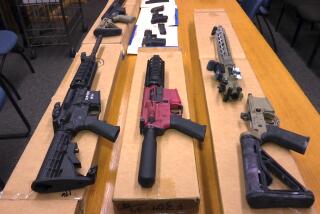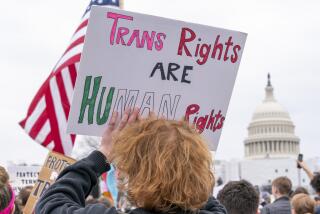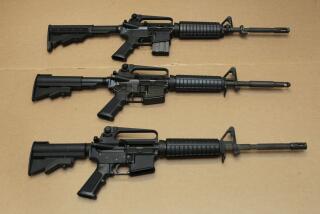Under the gun
- Share via
Today the U.S. Supreme Court hears arguments in a gun-control case,1,7919861.story that offers the justices an opportunity to display the “judicial modesty” championed by Chief Justice John G. Roberts Jr. during his confirmation hearings. The danger is that the more conservative members will press for an unnecessarily sweeping ruling that would doom not only the Washington, D.C., ordinance before the court -- which includes a blanket ban on handguns -- but much more reasonable regulations as well.
Fortunately, it isn’t just gun-control advocates who are warning against such a stampede. So is U.S. Solicitor General Paul D. Clement, the Bush administration’s chief courtroom lawyer. Clement has told the court :// www.scotusblog.com/wp/wp-content/uploads/2008/01/us-heller-brief-1-11 -08.pdf “> www.scotusblog.com/wp/wp-content/uploads/2008/01/us-heller-brief-1-11 -08.pdf that even if the 2nd Amendment protects an individual right to keep and bear arms, that right is subject to reasonable regulation in the interests of public safety. Such regulation, Clement suggested, includes laws prohibiting the possession of machine guns.
Until recently, the scope of an individual right to keep and bear arms was not an issue. For almost 70 years, courts have assumed that the 2nd Amendment protects the collective right of the states to protect themselves. That interpretation is suggested by the wording of the amendment: “A well regulated militia, being necessary to the security of a free state, the right of the people to keep and bear arms, shall not be infringed.” But some legal historians have argued, notwithstanding the reference to the militia, that the amendment also protects a personal right to bear arms.
Yet even they don’t suggest that the right to bear arms is absolute. The constitutional scholar Leonard W. Levy agrees that “the origins of the [2nd] Amendment show that the right to keep and bear arms has an illustrious history connected with freedom, even if it is a right that must be regulated.” The question likely to dominate today’s oral arguments is what standard the courts should use in deciding which particular restrictions on firearms are permissible.
The case before the Supreme Court will reverberate nationally, of course, but it has special implications for California. Backed by strong popular and police support for gun control, the state and its municipalities have long been in the forefront of regulating weapons. Waiting periods, assault weapons bans, microstamping of bullets and restrictions on handguns have all found approval in our gun-wary state. A broad court ruling could undermine those important accomplishments, painstakingly built over many years.
The Washington ordinance pushes the constitutional envelope. It not only bans the possession of all handguns after a certain date, it requires owners of long guns to dismantle them if they are kept at home. In invalidating the law, the U.S. Court of Appeals for the District of Columbia Circuit did several things: It accepted that the right to keep and bear arms was an individual right; it concluded that the handguns targeted by the law are the descendants of the weapons in “common use” in the nation’s early days; and it argued that individual rights under the 2nd Amendment are subject to “the sort of reasonable restrictions that have been recognized as limiting, for instance, the 1st Amendment.”
The problem is that, when it comes to laws affecting freedom of speech and press -- rights guaranteed by the 1st Amendment -- the courts have looked with what an English judge once called “eagle eyes,” striking down restrictions on expression that were not narrowly tailored to achieve a compelling government interest. The appeals court flirted with the idea that the individual right to keep and bear arms is equally fundamental. So does a brief signed by 305 members of Congress and Vice President Dick Cheney (the Bush administration’s most celebrated gun enthusiast).
But there is a plain textual difference between the rights guaranteed by the 1st and 2nd Amendments. The 1st insists that Congress -- and later, by extension, the states -- may pass “no law” that interferes with the rights it protects. The 2nd is qualified by the language regarding militias and thus, on its face, more equivocal. Appropriately, then, Clement takes a less reckless view than Cheney and his fellow enthusiasts, arguing that the appeals court’s sweeping definition of an individual right to keep and bear arms could jeopardize federal gun-control statutes. He suggests that the Supreme Court justices remand the case to the appeals court so the law’s constitutionality can be assessed on narrower grounds. That sounds a lot like the approach Roberts advocated when he told the Senate in 2005 that the job of a judge is not to make law but rather to “decide cases.”


